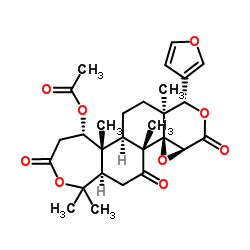1-(Acetyloxy)-1,2-dihydroobacunoic Acid e-Lactone

1-(Acetyloxy)-1,2-dihydroobacunoic Acid e-Lactone structure
|
Common Name | 1-(Acetyloxy)-1,2-dihydroobacunoic Acid e-Lactone | ||
|---|---|---|---|---|
| CAS Number | 1063-77-0 | Molecular Weight | 514.564 | |
| Density | 1.3±0.1 g/cm3 | Boiling Point | 657.7±55.0 °C at 760 mmHg | |
| Molecular Formula | C28H34O9 | Melting Point | 278-279° | |
| MSDS | Chinese USA | Flash Point | 351.6±31.5 °C | |
Use of 1-(Acetyloxy)-1,2-dihydroobacunoic Acid e-LactoneNomilin is a limonoid compound obtained from the extracts of citrus fruits. Nomilin is an anti-obesity and anti-hyperglycemic agent [1][2]. |
| Name | Nomilin |
|---|---|
| Synonym | More Synonyms |
| Description | Nomilin is a limonoid compound obtained from the extracts of citrus fruits. Nomilin is an anti-obesity and anti-hyperglycemic agent [1][2]. |
|---|---|
| Related Catalog | |
| In Vitro | Nomilin treatment significantly mitigated cell death and decreased lactate dehydrogenase (LDH) release and ROS production in SH-SY5Y cells induced by oxygen-glucose deprivation (OGD), which was almost abolished by Nrf2 knockdown[1]. |
| In Vivo | Nomilin attenuated blood-brain barrier (BBB) disruption in MCAO rats, which might be associated with alleviating the loss of tight junction proteins, including ZO-1 and occludin-5[1]. |
| References |
[2]. Sato R, et al. Nomilin as an anti-obesity and anti-hyperglycemic agent. Vitam Horm. 2013;91:425-39. |
| Density | 1.3±0.1 g/cm3 |
|---|---|
| Boiling Point | 657.7±55.0 °C at 760 mmHg |
| Melting Point | 278-279° |
| Molecular Formula | C28H34O9 |
| Molecular Weight | 514.564 |
| Flash Point | 351.6±31.5 °C |
| Exact Mass | 514.220276 |
| PSA | 121.64000 |
| LogP | 2.47 |
| Vapour Pressure | 0.0±2.0 mmHg at 25°C |
| Index of Refraction | 1.575 |
|
Comparative metabolic and transcriptional analysis of a doubled diploid and its diploid citrus rootstock (C. junos cv. Ziyang xiangcheng) suggests its potential value for stress resistance improvement.
BMC Plant Biol. 15 , 89, (2015) Polyploidy has often been considered to confer plants a better adaptation to environmental stresses. Tetraploid citrus rootstocks are expected to have stronger stress tolerance than diploid. Plenty of... |
|
|
Development of delayed bitterness and effect of harvest date in stored juice from two complex citrus hybrids.
J. Sci. Food Agric. 96 , 422-9, (2015) Mandarins and mandarin hybrids have excellent flavor and color attributes, making them good candidates for consumption as fresh fruit. When processed into juice, however, they are less palatable, as t... |
|
|
Evaluation of Physiological Activities of the Citron (Citrus junos Sieb. ex TANAKA) Seed Extracts.
Prev. Nutr. Food Sci. 18 , 196-202, (2014) Citron seed extracts (CSEs) were made using distilled water (CSEW), ethanol (CSEE), and n-hexane (CSEH), to measure the total polyphenol contents, DPPH and ABTS radical scavenging activities, and anti... |
| fromcitrusseeds |
| 1-(Acetyloxy)-1,2-dihydroobacunoic Acid e-Lactone |
| Oxireno[4',5']pyrano[4',3':5,6]naphth[2,1-c]oxepin-3,10,12(1H,4H,10aH)-trione, 5-(acetyloxy)-8-(3-furanyl)decahydro-1,1,5a,7a,11b-pentamethyl-, (5S,5aR,5bR,7aS,8S,10aS,11aR,11bR,13aR)- |
| (5S,5aR,5bR,7aS,8R,10aS,11aR,11bR,13aR)-8-(furan-3-yl)-1,1,5a,7a,11b-pentamethyl-3,10,12-trioxohexadecahydrooxireno[4,4a]isochromeno[6,5-g][2]benzoxepin-5-yl acetate |
| (5S,5aR,5bR,7aS,8S,10aS,11aR,11bR,13aR)-8-(3-Furyl)-1,1,5a,7a,11b-pentamethyl-3,10,12-trioxohexadecahydrooxireno[4,4a]isochromeno[6,5-g][2]benzoxepin-5-yl acetate |
| 1-(3-Furyl)decahydro-11-hydroxy-4b,7,7,11a,13a-pentamethyloxireno(4,4a)-2-benzopyrano[6,5-g](2)benzoxepin-3,5,9(3aH,4bH,6H)-trione Acetate |

